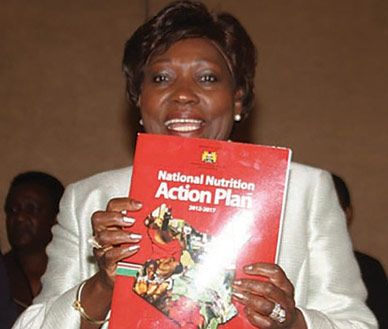Fighting Malnutrition Together
Kenya’s journey began in earnest when it signed up to the Scaling Up Nutrition (SUN) Movement in August 2012. An official launch was organized in November 2012 through the convening of a national symposium on SUN under the then Minister of Public Health (MoPH). The Natonal Nutriton Action Plan was launched and a SUN Government Focal Point was appointed.
[vc_row row_type=”row” text_align=”left” css_animation=””][vc_column width=”1/2″]

Different groups are acting together to develop a harmonized approach to nutrition advocacy, communication and social mobilization in Kenya.
Terry Wefwafwa, Director of Nutrition, Ministry of Health and SUN Government Focal Point provides the background…[/vc_column_text][/vc_column][/vc_row][vc_row row_type=”row” text_align=”left” css_animation=””][vc_column][vc_separator type=”transparent”][/vc_column][/vc_row][vc_row row_type=”row” text_align=”left” css_animation=””][vc_column][vc_column_text custom_options=””]Kenya’s journey began in earnest when it signed up to the Scaling Up Nutrition (SUN) Movement in August 2012. An official launch was organized in November 2012 through the convening of a national symposium on SUN under the then Minister of Public Health (MoPH). The Natonal Nutriton Action Plan was launched and a SUN Government Focal Point was appointed. These concrete steps have helped to accelerate SUN advocacy while government representatives, regional and county health management teams, different sectors, funding and implementing partners have joined forces to support the nutrition agenda.[/vc_column_text][/vc_column][/vc_row][vc_row row_type=”row” text_align=”left” css_animation=””][vc_column][vc_separator type=”transparent”][/vc_column][/vc_row][vc_row row_type=”row” text_align=”left” css_animation=””][vc_column][vc_column_text custom_options=””]A Nutrition Advocacy and Communication Committee (NACC) was formed in June 2013 to address advocacy issues in Kenya consisting of representatives from the government, non-governmental organisations and United Nations (UN) agencies. Four taskforces were established to guide and implement the work of the committee:
i) focusing on the Lancet series,
ii) Nutrition action plan dissemination at national and county level,
iii) advocacy and communication strategy development and
iv) multimedia messaging.

Each taskforce was formed with a specific purpose and function in mind. The Lancet series has proved valuable in providing the requisite evidence base to link nutrition and health, and to inform the advocacy focus in country. The National Nutrition Action Plan is the central advocacy tool for the NACC with its dissemination ensuring further profiling for nutrition while an advocacy, communication and social mobilisation strategy will provide the framework for implementation of activities. Multimedia messaging is proving an important and effective tool for securing the required attention from relevant stakeholders.[/vc_column_text][/vc_column][/vc_row][vc_row row_type=”row” text_align=”left” css_animation=””][vc_column][vc_separator type=”transparent”][/vc_column][/vc_row][vc_row row_type=”row” text_align=”left” css_animation=””][vc_column][vc_column_text custom_options=””]
Building a civil society alliance for nutrition
The Nutrition Interagency Coordination Committee (NICC) serves as the multi-sector coordination body at national level, with active participation from civil society. The Nutrition Technical Forum previously served as the civil society network (CSN), active at national level and being rolled out to counties. Efforts to expand the network to include other nutrition sensitive actors led to a realigning and revamping of the CSN in November 2013. The new civil society alliance (CSA) was formally launched in May 2014 with current members spanning non-governmental organisations (NGOs), human rights bodies, consumer organizations, women youth and gender organizations and development organizations.
Advocacy, communication and social mobilization (ACSM), has played a key role in achieving government commitments, establishing coordination structures and SU networks as well as in advancing the ongoing nutrition work in the country. In the past, advocacy and communication within the nutrition sector has been undertaken on an ad hoc basis and for specific programmes although there are plans to have a harmonized advocacy, communication and social mobilization strategy. An ACSM strategy has been drafted by the NACC and is in the process of being reviewed by all stakeholders. The National Nutrition Action Plan has been used as the main tool for nutrition advocacy and resource mobilization. [/vc_column_text][/vc_column][/vc_row][vc_row row_type=”row” text_align=”left” css_animation=””][vc_column][vc_separator type=”transparent”][/vc_column][/vc_row][vc_row row_type=”row” text_align=”left” css_animation=””][vc_column]
Evolution of the SUN civil society alliance in Kenya
- October 2013: Taskforce in Nutrition Technical Forum established
- November 2013: SUN CSA interim governance established with World Vision as host and Action Contre la Faim appointed as focal point/chair
- February 2014: SUN CSA awarded USD 280,000 through Multi-Partner Trust Funds to implement workplan
- May 2014: New SUN CSA launched and Global Day of Action for Nutrition held
- Mapping of CSOs ongoing at national and county level – consumer groups have joined
- Nutrition advocacy capacity building started (Kenya Aids NGO Consortium supported training)
- Exchange learning with Zambia SUN CSA
- Endorsed position papers including draft Kenya Health Policy
- Recruited National SUN CSA Coordinator
- Planning to support analysis of County Integrated Action Plans, and budgets
Priorities for advocacy, communication and social mobilization
Within the National Nutrition Action Plan, the key ACSM priorities and actions have been defined as follows:
- Position nutrition as a clear developmental agenda in the country
- Develop, disseminate and implement a national nutrition advocacy, communication and social mobilization (ACSM) strategy at all levels
- Advocate and create awareness about food fortification, supplementation and dietary diversification
- Promote exclusive breastfeeding and optimal complementary feeding
- Promote healthy dietary practices
- Create public awareness about the importance of prevention, management and control of diet related non-communicable diseases
- Advocate and mobilize financial and human resources for nutrition coordination and partnership activities at all levels
- Establish and/or strengthen multi-sector coordination mechanisms and networks for nutrition at all levels
[/vc_column_text][/vc_column][/vc_row][vc_row row_type=”row” text_align=”left” css_animation=””][vc_column][vc_separator type=”transparent”][/vc_column][/vc_row][vc_row row_type=”row” text_align=”left” css_animation=””][vc_column][vc_column_text custom_options=””]
Achievements
A major achievement has been the formation of an advocacy, communication and social mobilization (ACSM) forum. The main roles of the ACSM forum are to:
- Undertake continuous contextual analysis and identification of ACSM priorities in line with sectoral priorities
- Develop and implement a harmonised nutrition ASCM strategy to influence policy and legislation, investment, practice and behaviour
- Review implementation of advocacy and communication strategies/mechanisms to ensure integration of nutrition within nutrition sensitive sectors (education, agriculture, child services etc.) at national and county levels.
- Advocate for financing ASCM activities.
An ACSM strategy has been developed and is in draft form.
The Lancet series on evidence based interventions for improving maternal and child nutrition was launched in
February 2014. This updated evidence has been useful for developing multimedia messaging which will be used as an advocacy tool with a focus on stunting.

There have also been achievements in building nutrition structures in Kenya. A high level SUN multi-stakeholder and multi-sector platform is being formed to complement the NICC. SUN Networks are being established and re-aligned and a SUN CSA has been established which will have a strong focus on support for ACSM. In addition, there have been extensive consultations with regard to identifying a high level champion for SUN.
Efforts have been made to engage/sensitize county leadership to include nutrition in the County Integrated
Development Plans (CIDPs) while there has been follow up to ensure that nutrition is well articulated in the national Health Policy.
Social mobilization and behaviour change and communication activities include dissemination of infant and young child feeding materials at national and county levels. In addition, a national iron and folic acid supplementation communication strategy, vitamin A supplementation communication strategy, maternal infant and young child nutrition strategy, and food fortification strategy have been developed.
Nutrition stakeholders continue to use existing structures including national health days/weeks such as ‘malezi bora’ (good nurturing) weeks, world breastfeeding week, world diabetes day as platforms for nutrition advocacy and social mobilization.
[/vc_column_text][/vc_column][/vc_row][vc_row row_type=”row” text_align=”left” css_animation=””][vc_column][vc_separator type=”transparent”][/vc_column][/vc_row][vc_row row_type=”row” text_align=”left” css_animation=””][vc_column][vc_column_text custom_options=””]
Challenges
The challenges ahead include limited prioritization of nutrition in political and economic agendas leading to very limited budget allocations for nutrition. The approach to ACSM is ad hoc and not systematic while the ACSM strategy is still not finalized and in place. In addition, financing support for the ACSM is low. For example, TV spots and radio messages have been developed under the food fortification programme but have not been aired regularly owing to funding constraints. There is limited capacity of ACSM expertise in the nutrition sector.[/vc_column_text][/vc_column][/vc_row][vc_row row_type=”row” text_align=”left” css_animation=””][vc_column][vc_separator type=”transparent”][/vc_column][/vc_row][vc_row row_type=”row” text_align=”left” css_animation=””][vc_column]
Key Lessons
- Strong advocacy, communication and social mobilization is key to Scaling Up Nutrition.
- Development of a national ACSM strategy should involve all relevant stakeholders at planning, development and dissemination stages to ensure proper representation.
- Collective responsibility in advocating for nutrition is required within and across networks. No one sector or network can do it alone.
- All stakeholders in SUN need to agree on the advocacy messages to be passed to the public to avoid conflicting information.